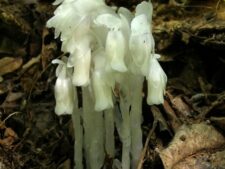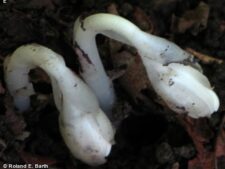
This native perennial plant looks more like a white fungus when it first emerges as a single waxy-white stem or several bunched together (A,C). It grows up to 8 inches tall. Their nodding flower heads have 4-6 translucent petals surrounding several yellow anthers and a central style (E,F). This unusual plant, which lacks chlorophyll, often has a pinkish hue (A,B), but later turns black with age (D). Its leaves are reduced to small scales (bracts) along the stem (A).
Found in moist woodlands, especially young (early-successional) oak-hickory forests. It is uncommon in the mature woodlands of Fontenelle Forest and Neale Woods. It seems less common than in earlier years, perhaps secondary to decrease in young successional woodlands as the woodlands mature. Look for them from July to September.
This unusual parasitic plant does not produce chlorophyll, relying on its association with certain species of fungi to obtain carbohydrates. The spreading fungal strands (mycorrhizae) are also intimately connected with nearby green plants and act as the intermediary in transfer of nutrients to Indian Pipe.
An alternate common name is Ghost Plant.
The content of NatureSearch is provided by dedicated volunteer Naturalists of Fontenelle Forest who strive to provide the most accurate information available. Contributors of the images retain their copyrights. The point of contact for this page is: Roland Barth.

 Identification
Identification



